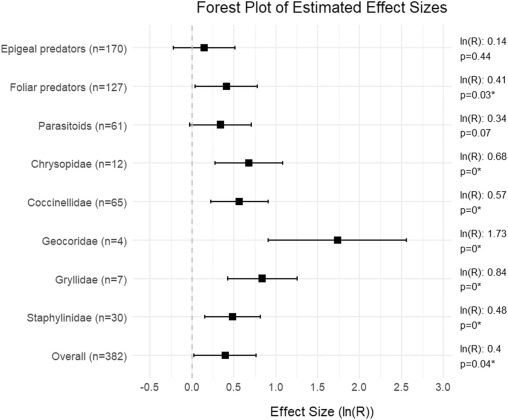If so, this could help Europe, which has declared it wants to reduce pesticides 50% by 2030 but found its efforts stymied when they had to engage in limited boycotts of its primary food exporter, Russia. Even though they exclude Organic™ pesticides from their goals, despite those being up to 600% more chemicals per calorie produced.(1)
It's a meta-analysis so the results are only EXPLORATORY but the results look good. The statistical analysis of other papers found that two or more flower species that attracted 'good' creatures had a benefit, but the more the better. A combination of things like ladybirds and soldier beetles attacked aphids, spider mites, and more, including the eggs and larvae of various pests.

Forest plot of estimated mean effect sizes for significant natural enemy families and functional groupings. Error bars are 95 % CI.
Two species of flowers in strips, like oxeye daisy (Leucanthemum vulgare), bellis and yarrow, attracted up to 70% more creatures like flower bugs, green lacewings, and hoverflies to block out crop-eating pests such as thrips as well as eggs and larvae, than if there were no flowers, and that
Unlike with toxic chemicals such as copper sulfate, more is better for the flowering kind of pesticide. Each additional species increased natural predators by just over four percent. The downside is the recommendations may not be 'one size fits all.' Oxeye daisy was brought to America by Europeans before they knew what an invasive species was, and it carries crop diseases that harm American plants.
The belief is that multiple species have a greater effect because they will flower at different times, keeping helpful critters fed longer, which keeps them pushing out crop-killing ones longer. They believe umbelliferous species work best because they have open flowers and that means easier access to nectar and pollen, which can keep good predators around until some protein comes along.
(1) It's hard to know now, perhaps they got better. The only area that itemized organic pesticides, rather than lumping them in with the modern ones that anti-science activists like Secretary Robert F. Kennedy, Jr., Greenpeace, and Pesticide Action Network do to protect their clients and donors in the organic space, was California, and after blowback from progressives, Governor Jerry Brown ordered the state to stop listing organic pesticides separately. Which meant those groups and others appealing to people who lack agricultural literacy even got to claim pesticide usage had gone up. Because organic pesticides were now lumped in with safer ones like glyphosate and atrazine so they could complain they had increased.



Comments